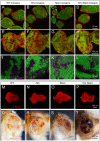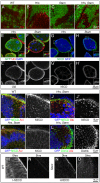ESCRT-0 is not required for ectopic Notch activation and tumor suppression in Drosophila
- PMID: 24718108
- PMCID: PMC3981749
- DOI: 10.1371/journal.pone.0093987
ESCRT-0 is not required for ectopic Notch activation and tumor suppression in Drosophila
Abstract
Multivesicular endosome (MVE) sorting depends on proteins of the Endosomal Sorting Complex Required for Transport (ESCRT) family. These are organized in four complexes (ESCRT-0, -I, -II, -III) that act in a sequential fashion to deliver ubiquitylated cargoes into the internal luminal vesicles (ILVs) of the MVE. Drosophila genes encoding ESCRT-I, -II, -III components function in sorting signaling receptors, including Notch and the JAK/STAT signaling receptor Domeless. Loss of ESCRT-I, -II, -III in Drosophila epithelia causes altered signaling and cell polarity, suggesting that ESCRTs genes are tumor suppressors. However, the nature of the tumor suppressive function of ESCRTs, and whether tumor suppression is linked to receptor sorting is unclear. Unexpectedly, a null mutant in Hrs, encoding one of the components of the ESCRT-0 complex, which acts upstream of ESCRT-I, -II, -III in MVE sorting is dispensable for tumor suppression. Here, we report that two Drosophila epithelia lacking activity of Stam, the other known components of the ESCRT-0 complex, or of both Hrs and Stam, accumulate the signaling receptors Notch and Dome in endosomes. However, mutant tissue surprisingly maintains normal apico-basal polarity and proliferation control and does not display ectopic Notch signaling activation, unlike cells that lack ESCRT-I, -II, -III activity. Overall, our in vivo data confirm previous evidence indicating that the ESCRT-0 complex plays no crucial role in regulation of tumor suppression, and suggest re-evaluation of the relationship of signaling modulation in endosomes and tumorigenesis.
Conflict of interest statement
Figures




References
-
- Babst M, Katzmann D, Estepa-Sabal E, Meerloo T, Emr SD (2002) Escrt-III: an endosome-associated heterooligomeric protein complex required for mvb sorting. Developmental cell 3: 271–282. - PubMed
-
- Babst M, Katzmann D, Snyder W, Wendland B, Emr SD (2002) Endosome-associated complex, ESCRT-II, recruits transport machinery for protein sorting at the multivesicular body. Developmental cell 3: 283–289. - PubMed
-
- Katzmann D, Babst M, Emr SD (2001) Ubiquitin-dependent sorting into the multivesicular body pathway requires the function of a conserved endosomal protein sorting complex, ESCRT-I. Cell 106: 145–155. - PubMed
Publication types
MeSH terms
Substances
Grants and funding
LinkOut - more resources
Full Text Sources
Other Literature Sources
Molecular Biology Databases

